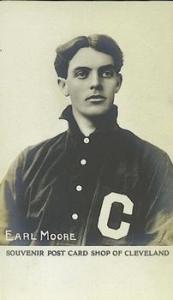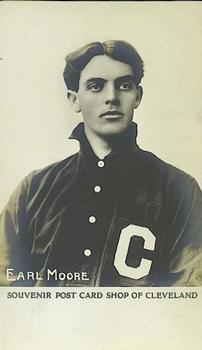May 1, 1901: Cleveland’s Earl Moore pitches with ‘quality of Cy Young’ in first home appearance
 As Earl Moore dominated the Class B Interstate League in 1900, it became clear that the Ohio native would not remain with the Dayton Veterans for very long. Moore’s pitches zipped and zagged past overmatched minor-league hitters. He looked like a major leaguer, but with a finite number of roster spots available in the eight-team National League, a jump directly from Dayton to the big leagues seemed unlikely – despite his strikeout prowess and 23 victories.1
As Earl Moore dominated the Class B Interstate League in 1900, it became clear that the Ohio native would not remain with the Dayton Veterans for very long. Moore’s pitches zipped and zagged past overmatched minor-league hitters. He looked like a major leaguer, but with a finite number of roster spots available in the eight-team National League, a jump directly from Dayton to the big leagues seemed unlikely – despite his strikeout prowess and 23 victories.1
One possible path for Moore’s advancement ran through Cleveland, home of the Class A Lake Shores of Ban Johnson’s American League – which had yet to declare its major-league status in 1900. After Moore struck out 11 Toledo Mud Hens on July 18, Toledo manager Charley Strobel acknowledged that he had sought out Cleveland manager James McAleer to make sure he knew about Moore’s blazing fastball.
“Manager Strobel has recommended Earl Moore to the Cleveland club,” read a report in the Dayton Daily News. “He thinks Moore is about the best pitcher in the Interstate League, and when he was in Cleveland recently, he was asked by the owners of that team what he thought of Moore. Manager Strobel does not think that Moore will be able to jump to the big league, as there are too many candidates from the American League for the major organization. One thing seems certain, and that is that Moore will not be with Dayton next season.”2
Moving to Cleveland and Class A competition was likely to give Moore’s skills more credibility with NL clubs, and the Lake Shores purchased his services in early September.3 As it happened, Moore reached the majors without needing more minor-league exposure, as Johnson soon declared the AL a major league, intent on directly competing with the NL in 1901. With Johnson’s declaration, Moore and his Lake Shores teammates became the major-league Cleveland Blues.
From minor-league prodigy to major-league ace in a matter of months. That is how Earl Moore arrived in Cleveland.
His arrival left local baseball fans achatter as the Cleveland Blues prepared for their first season in the revamped AL. Moore had already gained notoriety in the city for his exploits in Dayton. As the club embarked on its first homestand of the season after opening with three losses in four games in Chicago, Cleveland fans eagerly awaited the 23-year-old Moore’s first start at League Park on May 1, 1901.
Even though their beloved Blues had suffered an embarrassing loss to the visiting Milwaukee Brewers the day before, a Wednesday afternoon crowd of 1,200 fans had plenty to cheer about when Moore made his home debut. The Blues’ offense quickly found its rhythm against Milwaukee rookie starter – and popular Cleveland native – Bill Reidy to back Moore’s complete-game effort for a 6-3 win in the third meeting of a four-game series.
Newspaper coverage drew a parallel between Moore and an ace pitcher from Cleveland’s days as a National League city in the 1890s. According to the Cleveland Plain Dealer, Moore “showed wonderful speed – almost up to the quality possessed by former Cleveland Spiders ace Cy Young in his best days – and fairly good control”4 in his first major-league victory. Moore showed “good evidence of ability”5 after striking out four. He allowed only three runs by dancing around five walks and six hits.
A day after Milwaukee snapped a five-game losing streak to get “through the swamp”6 for its first win of the season, the Brewers could not parlay it into a winning streak.7
Moore retired the Brewers in order in the top of the first inning, and his offense generated more than enough support with four runs in the bottom half. After the crowd gave Reidy a hearty round of applause, Jack McCarthy and Frank Genins swatted back-to-back one-out singles to put runners on the corners, and a double steal that followed produced a run. Then Reidy walked Candy LaChance and hit Bill Bradley with a pitch to load the bases, and Erve Beck drove in a run on a groundout before Danny Shay smacked a two-run single for the second straight game.8
More aggressive baserunning increased the Blues’ lead in the third. LaChance and Beck singled to put runners on first and second. As LaChance stole third, a bad throw from Milwaukee catcher Tom Leahy sailed into the outfield to produce a run. Cleveland added another run in the fifth as Bradley walked, stole second, moved to third on Shay’s single, and scored when Bob Wood grounded out for a 6-0 lead.
In total, Cleveland pounded out 11 hits. The Blues did not produce many hard hits – Ollie Pickering and Genins doubled – but the consistency of nine singles kept Reidy on his toes in the second of what turned out to be 20 losses in 1901.
The Brewers answered with a small rally in the sixth, garnering a pair of runs after Irv Waldron reached on a fielder’s choice and Billy Gilbert singled. Both advanced on a wild pitch and scored on John Anderson’s “clean drive” through the infield.9 Moore labored in the ninth, allowing Milwaukee to load the bases on a single and two walks. The Brewers scratched across a run when Waldron grounded out, but the game ended when Wood’s throw thwarted Waldron’s attempt to steal second.
“The only blue sky to be seen,” the Milwaukee Journal wrote, “is that they have worked their loose play from the last to the first innings, and as that is backwards, there is little hope there except that it shows them to be capable of change.”10 But the Brewers’ season did not get much better, as they closed the campaign with a major-league-worst 48-89 record. The franchise relocated to St. Louis for the 1902 season and was rebranded as the Browns.11
Milwaukee salvaged a series split with a 9-7 victory on May 2 – a precursor to one of the worst stretches of baseball in Cleveland’s history. From May 5 to 17, the Blues lost 11 games in a row – a record of futility that stood until 1931.12 Cleveland recovered from its low-water mark of 4-17 but never found a regular winning flourish, closing the campaign seventh in the AL at 54-82.
Eight days after his debut game, Moore pitched nine hitless innings against the Chicago White Stockings on May 9 before taking a hard-luck loss in the 10th inning. He contributed to nearly 30 percent of Cleveland’s victories in 1901, going 16-14 as the only Blues pitcher over .500 in the team’s inaugural season and outdueling Cy Young himself in Cleveland’s 10-inning win over the Boston Americans on July 19. Baseball-Reference.com credits Moore with 5.0 Wins Above Replacement as a pitcher in 1901, the sixth-highest total in the AL.
Moore soon became an elite starter in AL circles, winning 20 games with a league-best 1.74 ERA in 1903. A move to the Philadelphia Phillies in 1908 led to further success in the NL, including finishing in the top 10 in all three Triple Crown categories with 22 wins, a 2.58 ERA, and a league-high 185 strikeouts in 1910.
Acknowledgments
This article was fact-checked by Joseph Wancho and copy-edited by Len Levin. Special thanks to the Milwaukee County Library for providing local newspaper articles about this game.
Sources
In addition to the sources cited in the Notes, the author consulted the Baseball-Reference.com, Stathead.com, and Retrosheet.org websites for pertinent materials and the box scores noted below. He also used information obtained from coverage by The Sporting News, the Cleveland Plain Dealer, and the Milwaukee Journal.
https://www.baseball-reference.com/boxes/CLE/CLE190105010.shtml
https://www.retrosheet.org/boxesetc/1901/B05010CLE1901.htm
Notes
1 “A Bitter Pill,” Dayton Daily News, July 19, 1900: 3.
2 “Baseball Gossip,” Dayton Daily News, July 19, 1900: 3.
3 The Dayton Daily News announced the sale in its September 4 edition, and the Cleveland Plain Dealer corroborated the report three days later.
4 “Well Deserved Victory,” Cleveland Plain Dealer, May 2, 1901: 6.
5 Charles W. Mears, “Shows Strength,” The Sporting News, May 11, 1901: 7.
6 “First Win for Brewers,” Milwaukee Journal, May 1, 1901: 12.
7 Milwaukee earned back-to-back wins for the first time by sweeping Cleveland in a four-game series at the Lloyd Street Grounds May 11-14.
8 Shay made his major-league debut on April 30, and in his first three games he collected five hits and five RBIs. From 1901 to 2022, only 55 players achieved the feat, including 10 others in 1901.
9 “Well Deserved Victory.”
10 “Back Into the Swamp,” Milwaukee Journal, May 2, 1901: 12.
11 The Browns later moved again, becoming the Baltimore Orioles in 1954.
12 Cleveland also lost 11 games in a row in 1909 and 1928 before dropping 12 straight games in 1931. That streak remains the franchise record as of the start of the 2023 season.
Additional Stats
Cleveland Blues 6
Milwaukee Brewers 3
League Park
Cleveland, OH
Box Score + PBP:
Corrections? Additions?
If you can help us improve this game story, contact us.


